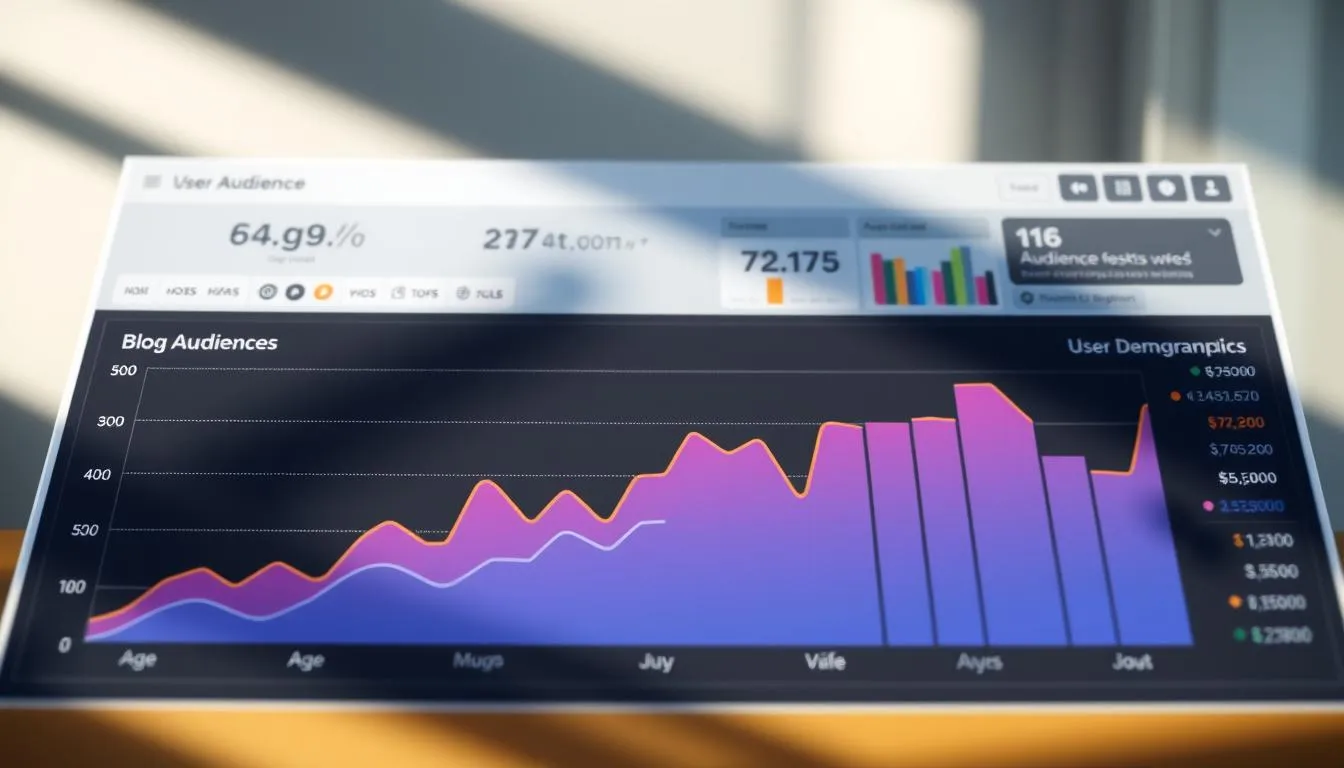Surprising fact: studies show over 60% of readers trust creators more when they share real numbers.
This section opens an honest conversation about how a blog makes money and why sharing those figures matters. Clear numbers are not bragging; they give a useful framework to show timelines, costs, and results.
Transparency helps an audience ask better questions and set realistic goals for their own journey. To build credible income through affiliate marketing, check out our guide on building wealth with evergreen affiliate pillars. When a post includes page views, sessions, and RPMs, it removes guesswork about how long growth takes and which channels pay.
What to expect: practical definitions, a checklist of what to include in an income report, and tips to use the data to make smarter choices for your website. For comprehensive guidance on setting up advertising revenue streams, explore our guide on setting up blog advertising slots. You’ll also see real examples—from first-month wins to year-long creator earnings and a zero-revenue year—to show different pathways.
Consistent reporting in a repeatable format makes patterns clear. For detailed analytics to support your income reporting, explore our guide on advanced traffic analytics dashboards. That alignment helps readers, sponsors, and creators set honest expectations about pace and potential.
Key Takeaways
- Sharing real numbers builds long-term trust with your audience.
- Income posts are frameworks, not boasts; they clarify timelines and costs.
- Include key metrics—page views, sessions, RPMs—to demystify monetization.
- Be selective: share relevant numbers and context, not every detail.
- Use a repeatable report format so trends and lessons become visible.
Setting the stage: why income talk belongs in modern blogging
Clear reports on money matters give readers a realistic map for where to spend their time. Open numbers help new and experienced creators benchmark progress by year and avoid unrealistic comparisons.
People are curious because concrete figures show which posts and channels deserve early focus. That curiosity is practical: it helps decide whether to test ads, build email lists, or chase partnerships.
- Benchmarks: compare yearly trends, not single wins.
- Context: sponsors see reach beyond vanity metrics.
- Growth: sharing ranges shows setbacks and steady gains.
| Yearly Benchmark | What to Share | Why It Helps |
|---|---|---|
| First year | Ranges for ad, affiliate, partnerships | Prevents unrealistic expectations |
| Mid growth | Top-performing posts and tests | Guides where to invest time |
| Pivot year | Decisions and rationale | Speeds learning for other creators |
Keep reports short, respectful of privacy, and consistent. Even brief updates compound in value and help monthly report examples become more insightful over time.
What is blog income transparency?
Readers learn more when creators label where revenue comes from and why. A clear report is a recurring post that summarizes revenue sources, costs, key metrics (sessions and page views), and lessons learned. That format helps people follow progress and compare results over time.

Clear definitions: income reports, affiliate links, and sponsored content
Income reports list monthly or yearly revenue streams, expenses, and performance so readers see the full picture. Affiliate links are specific URLs that earn a small commission when a reader buys through them at no extra cost.
How and when to disclose affiliate links and paid partnerships in a post
- Sample disclosure: “This post may contain paid and/or affiliate links. I make a small commission at no extra cost to you. Please see our Privacy Policy.” Place this near the top of the content.
- Differentiate sponsored work: a brand pays a flat fee for coverage; affiliate payouts depend on purchases via designated links.
- Put disclosures before the first outbound affiliate link and repeat when a post mentions brands or paid partnerships.
- Keep a dedicated disclosure/privacy page on your website and link to it from each relevant post.
| Item | What to include | Why it matters |
|---|---|---|
| Report type | Monthly or yearly revenue and key metrics | Shows trends and lessons |
| Affiliate | List programs and note link behavior | Clarifies where commissions come from |
| Sponsored | State brand partnerships and scope | Distinguishes paid coverage from editorial picks |
| Disclosure | Top-of-post notice + privacy page link | Protects trust and meets compliance |
Why income transparency matters for bloggers and readers
Sharing candid details about performance helps readers see what steady work produces over a year. Trust grows when a creator lists both wins and the steps behind them.
Trust and credibility: aligning with your audience and brands
Honest reports show the work—outreach, deliverables, follow-ups—and not just highlights. That detail builds credibility with an audience and signals to brands that you track results and meet deadlines.
“Reliable reporting proves you do the work and can repeat results.”
Realistic expectations: timelines, page views, and the myth of overnight money
Expect delays: many paid partnerships use Net 30-60 terms, so payment can arrive one to two months after the work is done. A creator’s year often mixes partnerships, freelance gigs, and low early ad or affiliate revenue while traffic grows.
Long-term benefits: SEO authority, community building, and repeat traffic
Consistent, reader-first content and clear reporting compound over time. Page views rise with quality posts, smart internal linking, and email updates.
For practical guidance and a model for openness, see this short resource on open reporting practices.

What to include in a transparent income report on your website
A clear report shows what worked, what cost money, and which channels paid off that month.
Revenue streams breakdown
Start with a short table of where money came from: ads, affiliates, paid partnerships, services, and products. That snapshot helps readers compare channels quickly.
Key performance metrics
Share monthly sessions, page views, RPM ranges, and notable shifts in views. Example: a strong first-month result might show 62,834 page views, ~33,000 sessions, and $1,668.36 from Google AdSense with RPMs of $24–$44.
Time, tools, and costs
List posting cadence (TikTok three times daily, one post per day, 2–3 daily Pinterest pins). Be candid about expenses: courses, hosting, SEO tool, Canva Pro, email, Grammarly, and occasional freelance setup.

Friendly disclosure language
Place a short disclosure at the top and before the first affiliate link. Link to your privacy/disclosure page for full context. Keep wording simple and consistent.
“Sharing numbers plus context lets readers use the data without guessing.”
- Annotate spikes: note tests like ad placement changes or targeting low-competition keywords.
- List costs: include courses and recurring tools so results show net reality.
- End with resources: name the one tool or course that truly helped that month.
Real-world transparency examples and takeaways from the blogging journey
Real examples show how traffic, strategy, and timing shape results during different growth phases.
First-month snapshot
Launch month results: March 29, 2024 to month end saw 62,834 page views and about 33,000 sessions.
Google AdSense paid $1,668.36 with RPMs of $24–$44. Focused keyword work, RankIQ research, daily posting, TikTok volume, and planned Pinterest pins drove those early views.
First-year creator snapshot
Year one totals: $77,202 earned in 2023. Paid partnerships made up ~65% and freelancing ~30%.
Ads and affiliates were small (1–2% total). Monthly totals swung between $1,112 and $14,049 as audience growth on Instagram and TikTok accelerated.
Zero-revenue year
One stretch (Nov 2023–Oct 2024) produced no revenue while the creator invested ~$4,144 in tools and courses.
Takeaway: planting seeds—content, SEO, and skill-building—often comes before steady returns.
- Early wins can happen: high RPMs plus focused keyword work drove rapid month results.
- Brands and freelancing: can dominate a year, creating lumpier monthly totals.
- Prep matters: quiet years are common and fund later stability in views and ads.
“Different seasons—launch, scale, and groundwork—each teach vital lessons for long-term growth.”
How to practice transparency in your own blog income reports
Make your reports usable: focus on clear numbers and a short plan readers can copy. Use a consistent monthly template that any creator can follow.
Monthly entries should list revenue by channel, sessions, page views, RPMs, notable experiments, and a 30-day action plan.
What to track monthly vs. yearly
Monthly logs capture quick tests and cadence: posts per day, social pushes, and short-run ad or affiliate results.
Annual rollups aggregate revenue by channel, highlight high-performing posts, and show year-over-year trends for strategic decisions.
Balance honesty with helpful context
State your niche, primary traffic sources, posting cadence, and platform pushes so readers can interpret results fairly.
Resources, services, and goals
Share only the resources and courses you use, why they mattered, and affordable alternatives for beginners.
List services you offer and whether they support growth or distract. Publish simple goals for traffic, SEO updates, and brand outreach and follow up next report.
| Period | Metrics to Log | Context Notes | Action |
|---|---|---|---|
| Monthly | Revenue by channel, sessions, page views, RPM | Posting cadence per day, platform pushes | 30-day testing plan |
| Quarterly | Top posts, affiliate links performance, services sold | Niche shifts, major campaigns | Adjust content and outreach |
| Yearly | Aggregate revenue, YoY trends, tool and course costs | Pivot decisions, long-term investments | Set annual goals and budget |
Conclusion
A short, honest wrap-up helps creators and readers spot what truly moved the needle.
Use an income report to show channels, costs, and the tests you ran each month. List ads, affiliate links, brand work, services, and products so readers see the full picture.
Practical checklist: disclose clearly, separate revenue streams, log page views and effort, and note which changes led to growth.
There’s no single right way to publish results. Different niches and creators find success by sharing context, asking good questions, and adapting to data over years.
If you have questions or metrics you want clarified next month, say so. Start tracking now—today’s notes become next year’s clearer story.
FAQ
What does “income transparency” mean for a blog and why should I care?
Income transparency means sharing clear, accurate reports about how a website earns money—ads, affiliate links, sponsored posts, services, and products. It helps build trust with readers, shows realistic timelines for growth, and offers practical lessons for creators who want to replicate or avoid the same paths. For brands, it signals credibility when partnering with a writer or creator.
What should an honest earnings report include?
A useful report breaks down revenue by stream (ads, affiliate, sponsorships, courses, freelance services), lists key performance metrics (sessions, page views, RPM, conversion rates), and explains expenses like hosting, SEO tools, or paid courses. Include dates, context about your niche and posting cadence, and any one-time payments so readers can interpret the numbers fairly.
How do I disclose affiliate links and sponsored partnerships properly?
Use clear, plain language at the top of posts and near each affiliate link stating you may earn a commission. For paid partnerships, mention the brand relationship and whether content was paid or gifted. Follow FTC guidelines and make disclosures obvious to readers, not buried in footers or long policy pages.
When is the best time to start sharing monthly or yearly reports?
Start when you have consistent data to share—typically after several months of tracking traffic and revenue. Early reports can be rough and framed as experiments. Transparent updates over time show progress and learning, even if the first months show little or no earnings.
Can sharing earnings hurt my partnerships or SEO?
Most brands appreciate transparency because it shows authenticity and results. SEO is unaffected by sharing revenue itself; what matters is quality content and proper use of links. Avoid oversharing private contract details, and focus on aggregated numbers and performance metrics that demonstrate value without exposing sensitive terms.
How do I present metrics so readers can understand context?
Pair raw numbers with brief explanations: traffic sources (search, social, email), posting frequency, seasonality, and niche competitiveness. Show trends rather than single data points, and clarify which figures are gross vs. net so readers can compare apples to apples.
What tools should I list in a resources section of an earnings post?
Share the specific tools you use for hosting (like Bluehost or Kinsta), analytics (Google Analytics, Plausible), SEO (Ahrefs, SEMrush), email (ConvertKit, Mailchimp), and affiliate networks (Amazon Associates, Impact). Only recommend tools you actually use and briefly note why they help your workflow.
How do I balance honesty with protecting my competitive edge?
Be candid about totals and performance drivers, but keep contract-level terms, client lists, and proprietary strategies private. Share actionable tips and high-level tactics that help readers without revealing step-by-step methods that competitors could copy easily.
Is it okay to include months with zero revenue in my reports?
Yes. Reporting zero-earning periods shows realism and helps set expectations for new creators. Explain what you invested in those months—courses, content creation, or technical setup—and how those efforts aimed to produce future growth.
How often should I update my audience on goals and progress?
Monthly or quarterly updates work well. Monthly posts give timely insights, while quarterly summaries let you show meaningful trends. Public goals for traffic, RPM, and monetization help keep you accountable and let readers follow your trajectory.
What are common mistakes to avoid in transparency posts?
Avoid cherry-picking only high-earning months, failing to explain context, and burying disclosures. Don’t present gross revenue as take-home pay without noting expenses and taxes. Keep language simple and friendly so readers of all levels can follow.
How can transparency improve SEO and audience loyalty?
Detailed, helpful reports can attract backlinks, social shares, and returning readers who value real data. Over time, consistent, quality reporting builds authority in search and fosters a community that trusts your recommendations and paid partnerships.
Should I include paid course revenue and freelance income in the same report?
Yes, include all meaningful streams but label them clearly—courses, freelance work, affiliate, ad revenue, and services. This clarity helps readers see which efforts scale and which are one-off or time-intensive.
How do I write a disclosure that feels friendly and trustworthy?
Use simple, conversational language: explain that some links earn a small commission, that partnerships are paid, and that you only promote products you use or believe in. Place the disclosure near the top and repeat it near affiliate links for extra clarity.
Where can I find examples of high-quality transparency reports to learn from?
Look at creators and publications that regularly publish detailed reports—Pat Flynn of Smart Passive Income and founders who share creator newsletters. Study their structure: clear revenue breakdowns, context, and honest commentary on what worked and what didn’t.
